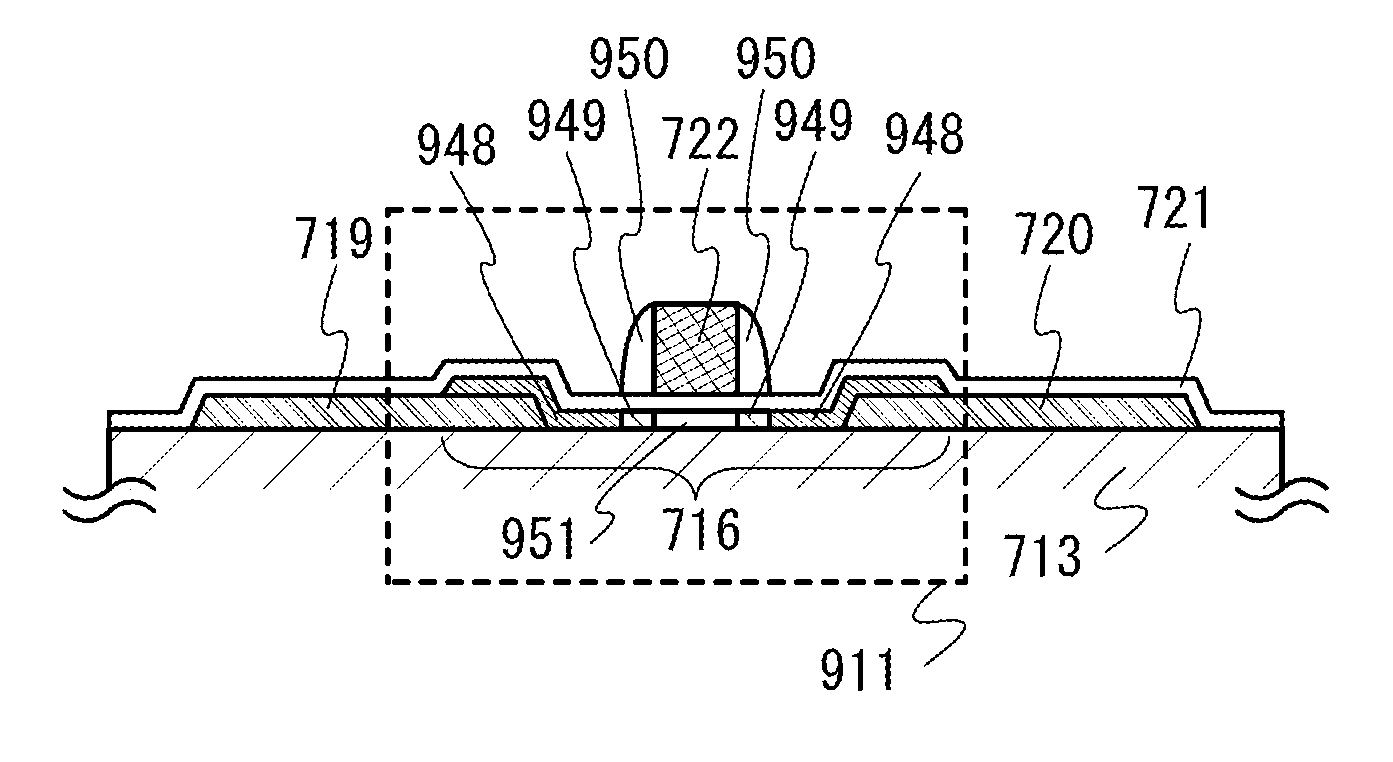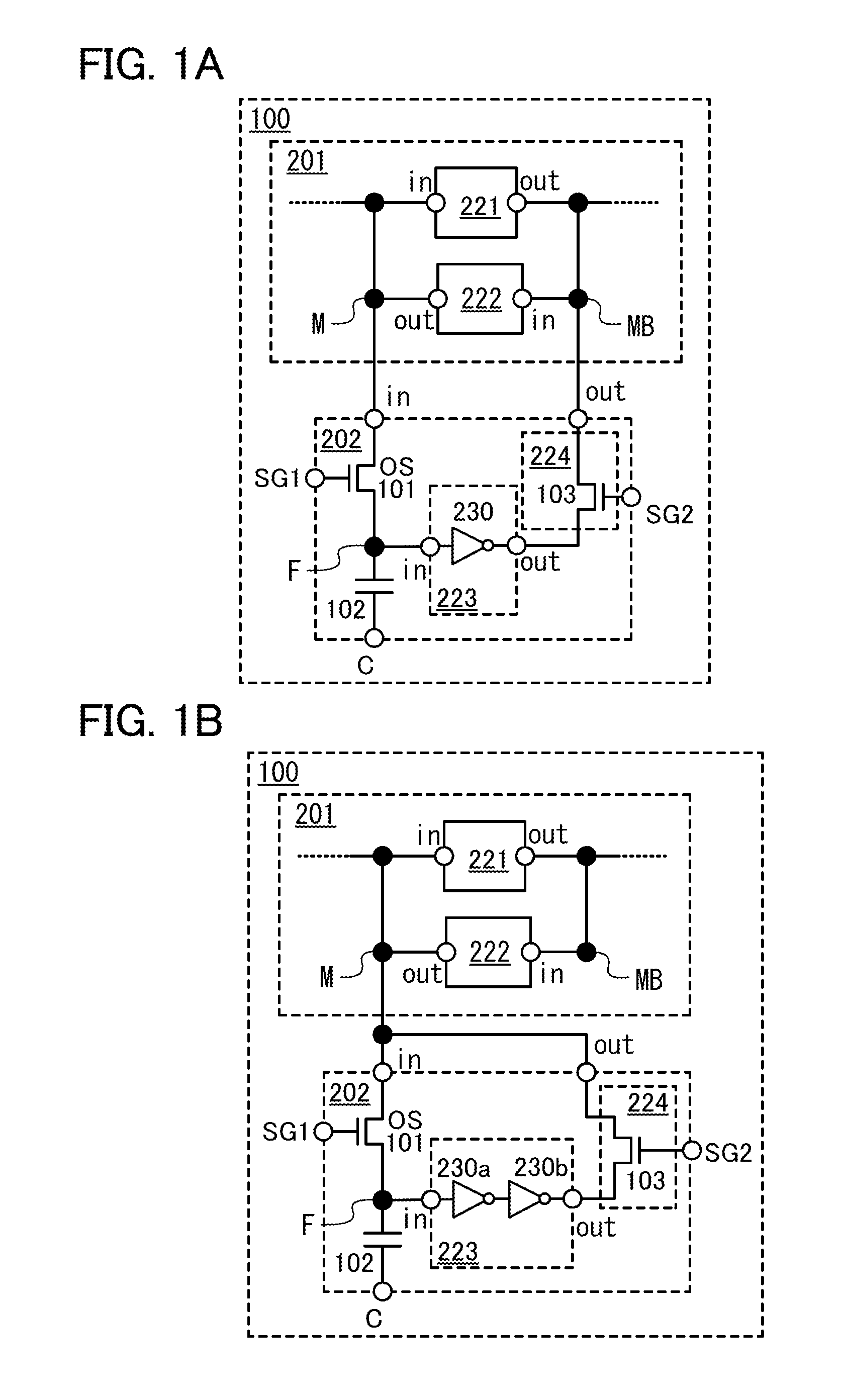Memory circuit, memory unit, and signal processing circuit
a memory circuit and signal processing technology, applied in the field of memory, can solve the problems of reducing the operation speed of the memory circuit, affecting the data return speed of the external memory unit, and affecting the data return speed of the volatile memory unit, so as to increase reduce the number of possible data rewriting operations, and reduce the mobility
- Summary
- Abstract
- Description
- Claims
- Application Information
AI Technical Summary
Benefits of technology
Problems solved by technology
Method used
Image
Examples
embodiment 1
[0060]The following describes one embodiment of a memory circuit according to the present invention. FIG. 1A shows the structure of a memory circuit.
[0061]In FIG. 1A, a memory circuit 100 includes a transistor 101 whose off-state current is extremely low, a capacitor 102, an arithmetic circuit 221, an arithmetic circuit 222, an arithmetic circuit 223, and a switch 224. The transistor 101 is a transistor whose channel is formed in an oxide semiconductor layer as an example, and is represented by “OS”. An output terminal of the arithmetic circuit 221 (represented by “out” in the figure) is electrically connected to an input terminal of the arithmetic circuit 222 (represented by “in” in the figure). The input terminal of the arithmetic circuit 222 is electrically connected to an output terminal of the arithmetic circuit 223 (represented by “out” in the figure) via the switch 224. An output terminal of the arithmetic circuit 222 (represented by “out” in the figure) is electrically conne...
embodiment 2
[0093]This embodiment shows another embodiment of the memory circuit according to the present invention. The configuration of the memory circuit 100 is shown in FIG. 3.
[0094]In FIG. 3, the memory circuit 100 includes a flip-flop circuit 201a, a flip-flop circuit 201b, a circuit 202a, and a circuit 202b. An output terminal of the flip-flop circuit 201a (represented by “out” in the figure) is electrically connected to an input terminal of the flip-flop circuit 201b (represented by “in” in the figure). An input terminal of the flip-flop circuit 201a (represented by “in” in the figure) serves as an input terminal D of the memory circuit 100, while an output terminal of the flip-flop circuit 201b (represented by “out” in the figure) serves as an output terminal Q of the memory circuit 100.
[0095]The circuit 202a and the circuit 202b may have the same configuration as that of the circuit 202 shown in FIG. 1A.
[0096]The flip-flop circuit 201a includes an arithmetic circuit 221a and an arithm...
embodiment 3
[0119]A method for manufacturing the memory circuit 100 in FIGS. 1A and 1B will be described. This embodiment describes a method for manufacturing the memory circuit 100 referring to elements in the memory circuit 100: the transistor 103, the transistor 101 whose channel is formed in an oxide semiconductor layer, and the capacitor 102. Here, the case where the transistor 103 is a transistor whose channel is formed in a silicon layer is described as an example.
[0120]First, as illustrated in FIG. 5A, an insulating film 701 and a semiconductor film 702 that has been separated from a single crystal semiconductor substrate are formed over a substrate 700.
[0121]Although there is no particular limitation on a material which can be used as the substrate 700, the material needs to have at least heat resistance high enough to withstand the subsequent heat treatment. For example, a glass substrate formed by a fusion process or a float process, a quartz substrate, a semiconductor substrate, a c...
PUM
 Login to View More
Login to View More Abstract
Description
Claims
Application Information
 Login to View More
Login to View More - R&D
- Intellectual Property
- Life Sciences
- Materials
- Tech Scout
- Unparalleled Data Quality
- Higher Quality Content
- 60% Fewer Hallucinations
Browse by: Latest US Patents, China's latest patents, Technical Efficacy Thesaurus, Application Domain, Technology Topic, Popular Technical Reports.
© 2025 PatSnap. All rights reserved.Legal|Privacy policy|Modern Slavery Act Transparency Statement|Sitemap|About US| Contact US: help@patsnap.com



